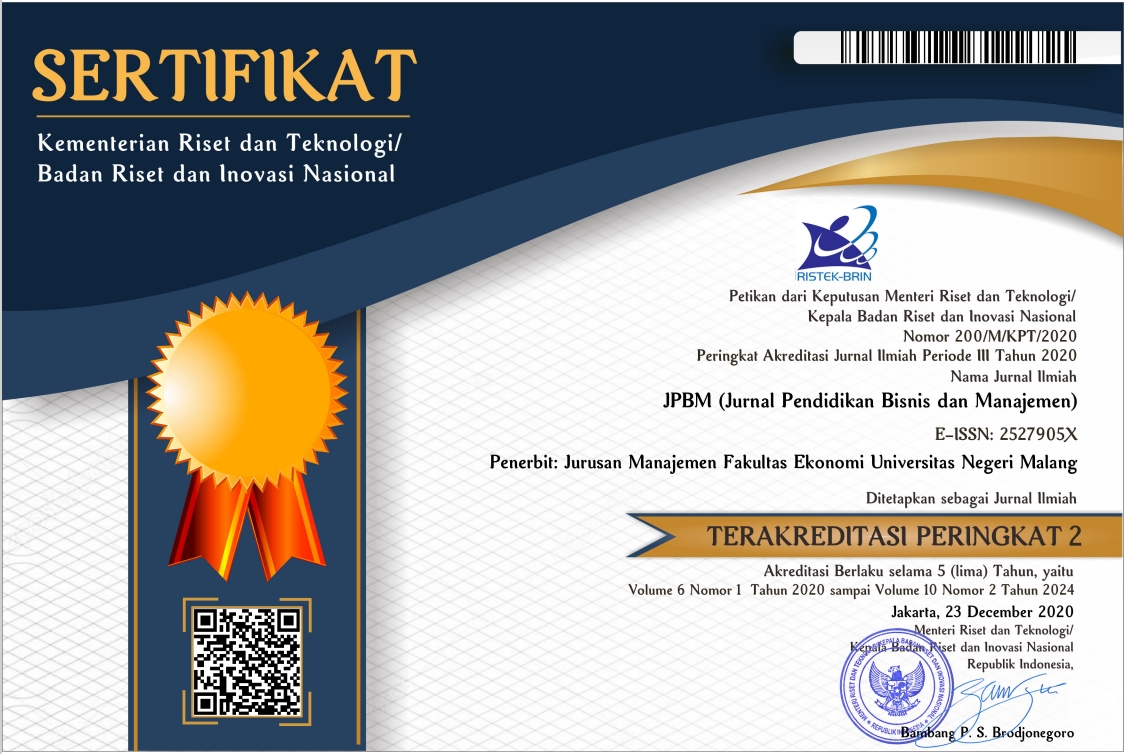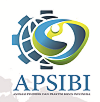Learning Flipped Model as Implementation of Inqury Revised Community to Enhance Economics Students' Learning Achievement
Abstract
Progress in technology impacts the educational sector, which allows teachers to build interactive learning programs. The goal of this study is to investigate the use of the flipped learning model to improve student learning outcomes as the implementation of the revised community of inquiry (RCOI). The research was carried out on students who took the course in Organizational Management, Management Study Program, Economics Faculty, Sanata Dharma University. A purposeful sampling method was used for the sampling technique, data mining used questionnaires for 163 respondents and classroom surveys. Three factors are included in the aspects examined, specifically the characteristics of the learning program, implementation and the outcomes obtained. The data analysis was using factor analysis. The findings showed that learners thought the stimuli using the flipped learning model made learning simpler and more autonomous for them and this RCOI measure provided its advantages in influencing the progress of their learning outcomes.
Keywords: Model Flipped Learning, Revised Community of Inquiry (RCOI), Students’ Learning Outcomes
Keywords
Full Text:
PDFReferences
Arnold-Garza, S., & Towson University, Albert S. Cook Library. (2014). The flipped classroom teaching model and its use for information literacy instruction. Comminfolit, 8(1), 7. doi: 10.15760/comminfolit.2014.8.1.161
Bennett, L. M., & Gadlin, H. (2012). Collaboration and team science: From theory to practice. Journal of Investigative Medicine: The Official Publication of the American Federation for Clinical Research, 60(5), 768–775. doi: 10.2310/JIM.0b013e318250871d
Cimatti, B. (2016). Definition, development, assessment of soft skills and their role for the quality of organizations and enterprises. International Journal for Quality Research, 10, 97–130. doi: 10.18421/IJQR10.01-05
Devlin, M., & Samarawickrema, G. (2010). The criteria of effective teaching in a changing higher education context. Higher Education Research & Development, 29(2), 111–124. doi: 10.1080/07294360903244398
Garrison, D.R., Cleveland-Innes, M., & Fung, T. S. (2010). Exploring causal relationships among teaching, cognitive and social presence: Student perceptions of the community of inquiry framework. The Internet and Higher Education, 13(1–2), 31–36. doi: 10.1016/j.iheduc.2009.10.002
Garrison, D. Randy, Anderson, T., & Archer, W. (1999). Critical inquiry in a text-based environment: Computer conferencing in higher education. The Internet and Higher Education, 2(2–3), 87–105. doi: 10.1016/S1096-7516(00)00016-6
Henderson, M., Selwyn, N., & Aston, R. (2017). What works and why? Student perceptions of ‘useful’ digital technology in university teaching and learning. Studies in Higher Education, 42(8), 1567–1579. doi: 10.1080/03075079.2015.1007946
Kim, M. K., Kim, S. M., Khera, O., & Getman, J. (2014). The experience of three flipped classrooms in an urban university: An exploration of design principles. The Internet and Higher Education, 22, 37–50. doi: 10.1016/j.iheduc.2014.04.003
Koehler, M. J., Mishra, P., & Cain, W. (2013). What is Technological Pedagogical Content Knowledge (TPACK)? Journal of Education, 193(3), 13–19. doi: 10.1177/002205741319300303
Krathwohl, D. R. (2002). A Revision of Bloom’s Taxonomy: An Overview. Theory into Practice, 41(4), 212–218. doi: 10.1207/s15430421tip4104_2
Kristanti, F. (2017). Developing competence, conscience, and compassion through reflective pedagogy. Proceedings of the Fifth International Seminar on English Language and Teaching (ISELT 2017). Presented at the Fifth International Seminar on English Language and Teaching (ISELT 2017), Padang, Indonesia. doi: 10.2991/iselt-17.2017.22
Lee, Y., & Martin, K. I. (2020). The flipped classroom in ESL teacher education: An example from CALL. Education and Information Technologies, 25(4), 2605–2633. doi: 10.1007/s10639-019-10082-6
Lin, M.-H., Chen, H., & Liu, kuang-S. (2017). A study of the effects of digital learning on learning motivation and learning outcome. EURASIA Journal of Mathematics, Science and Technology Education, 13(7). doi: 10.12973/eurasia.2017.00744a
McKerlich, R., Riis, M., Anderson, T., & Eastman, B. (2011). Student perceptions of teaching presence, social presence, and cognitive presence in a virtual world. Retrieved from https://auspace.athabascau.ca/handle/2149/3519
Roberts, T. G. (2006). The influence of student learning experience level and learning style on achievement. Journal of Agricultural Education, 47(4), 112–122. doi: 10.5032/jae.2006.04112
Sari, N. (2013). The importance of teaching moral values to the students. Journal of English and Education, 1(1), 154–162.
Shea, P., & Bidjerano, T. (2010). Learning presence: Towards a theory of self-efficacy, self-regulation, and the development of a communities of inquiry in online and blended learning environments. Computers & Education, 55(4), 1721–1731. doi: 10.1016/j.compedu.2010.07.017
Swan, K., Matthews, D., Bogle, L., Boles, E., & Day, S. (2012). Linking online course design and implementation to learning outcomes: A design experiment. The Internet and Higher Education, 15(2), 81–88. doi: 10.1016/j.iheduc.2011.07.002
Widoyoko, S. E. P. (2009). Evaluasi program pembelajaran: Panduan praktis bagi pendidik dan calon pendidik. Pustaka Pelajar.
Yot-Domínguez, C., & Marcelo, C. (2017). University students’ self-regulated learning using digital technologies. International Journal of Educational Technology in Higher Education, 14(1), 38. doi: 10.1186/s41239-017-0076-8
Zainuddin, Z., & Halili, S. H. (2016). Flipped classroom research and trends from different fields of study. The International Review of Research in Open and Distributed Learning, 17(3). doi: 10.19173/irrodl.v17i3.2274
Zerihun, Z., Beishuizen, J., & Van Os, W. (2012). Student learning experience as indicator of teaching quality. Educational Assessment, Evaluation and Accountability, 24(2), 99-111.
DOI: http://dx.doi.org/10.17977/um003v6i22020p054
Refbacks
- There are currently no refbacks.
JPBM (Jurnal Pendidikan dan Bisnis Manajemen) is licensed under a Creative Commons Attribution-NonCommercial-ShareAlike 4.0 International License.
JPBM (Jurnal Pendidikan dan Bisnis Manajemen) is abstracted and indexed in :
















